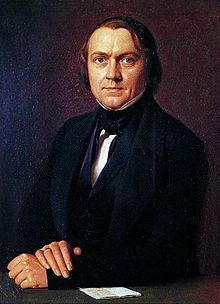Role Danish Politician | Name Ditlev Monrad | |
 | ||
Born 24 November 1811Copenhagen ( 1811-11-24 ) Died March 28, 1887, Nykobing Falster, Denmark Children Louise Dorothea Monrad, Christian Karl Monrad, Johannes Monrad, Viggo Monrad | ||
Ditlev Gothard Monrad (24 November 1811 – 28 March 1887) was a Danish politician and bishop of Lolland–Falster.
Monrad's father, Otto Sommer Monrad, an attorney, suffered from mental illness, and spent some years in institutions; he died in 1863.
Monrad studied theology and became a Lutheran minister, while beginning to participate in politics. He became editor of the Liberal publication, Fædrelandet, in 1840, and was leader of the National Liberal Party and spearheaded the movement towards a constitutional Denmark after 1848, the year in which he became a bishop. In the following year, he became a member of Parliament and was Minister of Church Affairs in the new government.
As Council President (1863-1864), he was the Danish state leader during the early part of Second Schleswig War, against the German Confederation led by Otto von Bismarck, which resulted in the Peace of Vienna.
After this war, a depressed and disillusioned Monrad emigrated to New Zealand. After sending his sons to Nelson and other districts of New Zealand to scout for land, he chose to settle in Palmerston North in the North Island of New Zealand. He bought 482 acres (1.95 km2) of land at Karere Block. He first lived in a small hut and then erected a timber house and started clearing bushland. He and his family farmed cows and sheep.
Monrad helped the New Zealand Company to find suitable settlers from Scandinavia and helped many Danish immigrants find land to settle on, most notably in the area of Dannevirke.
His work was disturbed by Māori rioters, members of the Hauhau cult under Chief Titokowaru. Monrad buried his belongings and went with the family to Wellington and then went back to Denmark in 1869. His sons Viggo and Johannes later returned to Karere to become farmers.
Before leaving New Zealand, he presented to New Zealand's Colonial Museum a collection of 600 woodcuts, etchings and engravings by European Old Masters, including Rembrandt, Hollar, Albrecht Dürer and van Dyck. They are now part of the collection at the Museum of New Zealand Te Papa Tongarewa where examples often feature in temporary exhibitions.
Monrad Intermediate is a Palmerston North intermediate school named after Monrad.
